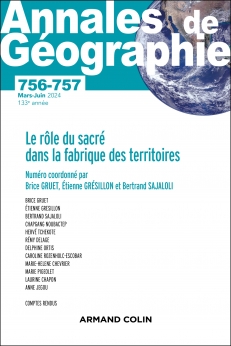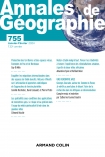
ANNALES DE GÉOGRAPHIE - N°756-757 (2-3/2024)
Pour acheter ce numéro, contactez-nous
Recevez les numéros de l'année en cours et accédez à l'intégralité des articles en ligne.
À Regla, quartier portuaire et périphérique en voie de désindustrialisation de La Havane, le fait religieux est un processus structurant de la fabrique territoriale et un élément identitaire fort pour les habitant.es. Le sacré se matérialise dans l’ensemble des espaces publics et est un facteur de mise en tourisme discret de l’espace. L’objectif de cet article est de montrer, à partir d’une enquête ethnographique longue, comment les pratiques religieuses, afro-cubaines et catholiques, sont des vecteurs de territorialisation à l’échelle du quartier. Le sacré structure le paysage urbain, tant dans les pratiques temporaires et événementielles, comme les pèlerinages (annuels ou quotidiens) que dans le paysage visuel et sonore et à l’échelle domestique et intime des foyers. Les acteurs religieux (chef du cabildo, prêtre de l’église catholique, santeros et babalaos) jouent un rôle majeur dans la fabrique de la ville ; il est intéressant d’analyser les interactions socio-politiques qui se jouent entre ces derniers et l’État à différentes échelles. Les pratiques afro-cubaines connaissent en effet des processus de patrimonialisation et de culturalisation qui contribuent à leur sécularisation, notamment opérée par l’État. Paradoxalement, ces processus renforcent aussi certaines croyances et pratiques, dans des espaces négociées entre différents acteurs. Questionner la fabrique territoriale au prisme du religieux est d’autant plus intéressant à Cuba qu’il permet de comprendre les interactions complexes qui se jouent, à différentes échelles entre citadins et État.
In Regla, a peripheral and port district in the process of deindustrialization of Havana, the religious fact is a structuring process of the territorial fabric and a strong identity element for the inhabitants. The sacred materializes in all public spaces and is a factor in the discrete tourism of space. The objective of this article is to show, from a long ethnographic survey, how religious practices, Afro-Cubans and Catholics, are vectors of territorialization at the neighborhood level. The sacred structures the urban landscape, both in temporary and eventful practices, such as pilgrimages (annual or daily) and in the visual and sound landscape and on the domestic and intimate scale of homes. Religious actors (head of the cabildo, priest of the Catholic Church, santeros and babalaos) play a major role in the urban fabric ; it is interesting to analyze the socio-political interactions that take place between these urban producers and the State at different scales. Afro-Cuban practices are indeed experiencing processes of patrimonialization and culturalization that contribute to their secularization, notably operated by the State. Paradoxically, these processes also reinforce certain beliefs and practices, in spaces negotiated between different actors. Questioning the territorial fabric through the prism of religion is more interesting in Cuba as it allows us to understand the complex interactions that take place, at different scales, between city dwellers and the State.

